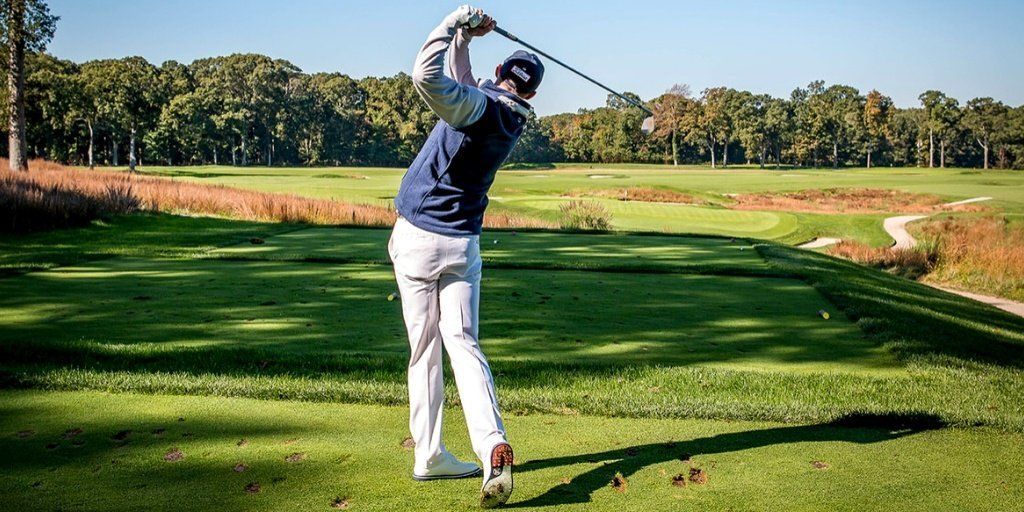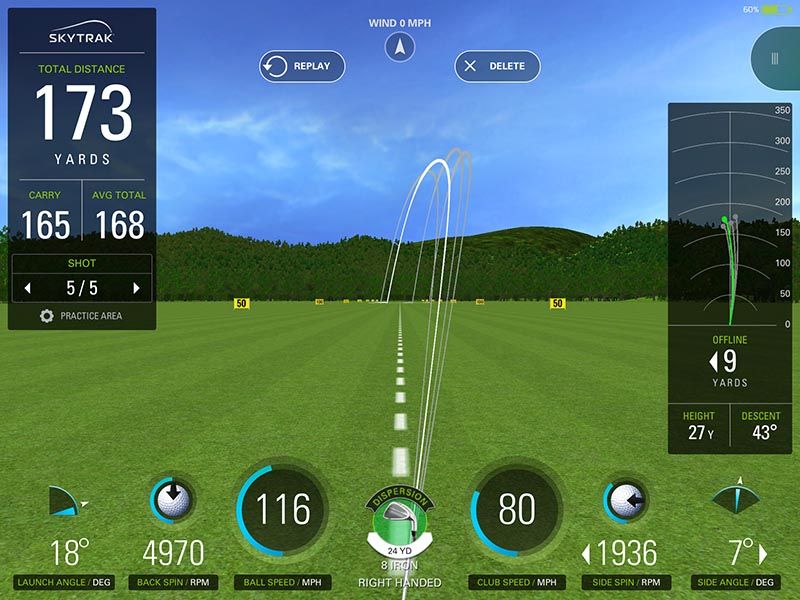
The position of your golf ball in your stance can have a significant influence on your ball flight. There are many theories regarding the optimal position for golfers, but in my estimation, there is no way to say there is one correct formula for all golfers. Each player's swing is unique, and it's very difficult to establish an accurate rule of thumb.
In this article, I want to show how golf ball position can alter your ball flight. I've done some interesting tests on my SkyTrak launch monitor with a short iron, mid iron, long iron, and driver. Additionally, I'll share some thoughts and a useful drill from one of the top teachers in the game.
I hope that you can use this information to experiment with your swing, and how moving the ball around may or may not improve your ball flight.
My Testing
For my test, I took full swings with my Sand Wedge, 8-iron, 5-iron, and driver. I made a series of shots from the center of my stance, several inches towards the back foot, and then towards my front foot. Any extreme outliers were removed, and the remaining data gave me a good estimation of how my ball flight changed.
All testing was done indoors using my SkyTrak launch monitor. You can check out my full review here, but this is a great product that will deliver accurate ball flight metrics for a test like this.

While I had some suspicions on what I thought would happen, I was looking for any significant changes in several areas. First and foremost, did my ball flight change at all? Almost every shot I hit moves in a draw pattern, but I was interested to find out if the ball moved from right to left even more.

I also explored a few other parameters such as:
- Launch Angle and total height - was my ball flying higher or lower based on where it was in my stance?
- Distance - am I gaining or losing carry and total yardages?
- Spin - is the ball spinning more or less?
- Dispersion - am I keeping the ball within a tighter right to left distribution, or am I less accurate?
Here are a few examples of how the data is presented via SkyTrak:


I'll summarize my findings on each club, but I want to make sure that you know these results are specific to my golf swing. You'll see some interesting changes in ball flight that you may or may not expect. However, you might find completely different results with your swing. I'm interested in showing you what is possible so you can experiment on your own.
Sand Wedge
For my short iron testing, I hit full swings with my Sand Wedge. Usually, this is a club that I will hit 100 yards with a draw. Typically I will play the ball in the middle of my stance on the course.
Here is a summary of my ball data:
The one thing that stood out with my Sand Wedge was distance. With the ball back in my stance, I was flying it 8 yards farther. This was mostly attributed to a big jump in ball speed, which I believe shows I was making better contact on the clubface from that position.
Other than that, my ball flight remained mostly the same regarding its shape, trajectory, and dispersion. I was surprised that I spun the ball the most and achieved peak height from the back of my stance as well. Most would assume that moving the ball back would keep the ball lower.
8-Iron
Next up is my 8-iron. This is a club I usually hit around 155-160 yards on the course and will see more of an exaggerated draw pattern compared to my shorter irons. Typically, I play these shots from the middle of my stance as well on the course.
Here is the summary of my ball data from SkyTrak:
The clear winner was the middle of my stance. Although I was hitting the ball farther from the back of my stance, this was the least accurate position with a total dispersion that was twice as wide.
With the ball in the front of my stance, I seemed to lose distance because of poorer contact with the ball. If you take a look at the comparison in ball flights you can see that the ball positioned in the middle produced the most stable ball flight that remained on target:

5-Iron
The last test of my irons was with a 5-iron. A typical shot will be around 185-190 yards. With my longer irons, I have started to play the ball more towards the front of my stance. I was interested to find out if this was a smarter strategy for my swing.
Here is the summary of my ball data:
Based on what I saw with my numbers, it seems my instincts were correct. With the ball in the front of my stance, I can hit the ball farther, higher, and reasonably accurate with my 5-iron. While the dispersion with the ball in the middle of my stance was slightly tighter, the ability to hit the ball higher with a long iron is critical.
Driver
I saved the best for last. Ball position with your driver is extremely important. I've done extensive testing with my ball position already, so I know what works for me (and many other golfers). But I want to take this opportunity to show what a dramatic difference ball position can do to your driver numbers.
Generically speaking, with the driver you want to launch the ball with as much speed as possible, on a higher trajectory, and with less spin. Every golfer is different so the optimal mixture can vary, but these are three goals to strive towards. Where you place the ball in your stance can have a significant impact on all of those numbers.
Let's take a look at my results:
As you can see it's not a close contest. Moving the ball up in my stance is a significant jump in performance. I'm launching it faster, higher, farther, and more accurately. With the ball forward in my stance, I am getting almost perfect numbers for my swing speed. With the ball in the middle or back of my stance, I am struggling to get the ball in the air which is greatly affecting its ability to fly as far as possible (which is what you want with the driver).
Key Takeaways
This test confirmed many of the tendencies I had noticed in my swing. One of the benefits of working with a launch monitor from time to time is that you can remove the guesswork from your game. I'm a big proponent of experimenting with small changes in your setup and swing to see if there is anything to be gained. When you can get instant feedback, it gives you more confidence on the course that what you are doing is the best decision for your swing.
Based on what I saw I believe I will continue playing the ball in the middle of my stance on most iron swings, except with long irons. Additionally, playing the ball towards the front of my stance is something I had known for a long time was giving me a better chance of hitting longer and straighter tee shots.
You might not see the same results in your swing. But I do believe almost any golfer would see differences in ball flight moving the ball around in their stance. Understanding how it can affect your particular swing might be something worth looking into.
A Drill For You
I want to provide a useful drill for everyone that relates to ball position. So I got in touch with Andrew Rice, who is a friend of Practical Golf. He's also one of the most highly respected teachers out there with an enormous online following and a Golf Digest Top 50 Instructor as well.
Andrew told me that, "ball position can be far more personal and unique than we give it credit for. Some golfers struggle to move the ball to fit the 'correct' position."
He has an interesting drill which he uses to help people who hit the ball either too high or too low. It might be counterintuitive to what some would expect, but Andrew says, "I try to get people who need to hit it higher to move the ball back and vice versa. It places a premium on incentivizing the golfer to make the necessary changes."
Here is a video of the drill that can be used with your wedges, or even any of your irons:
Golf Ball Position - Wrapping It Up
I genuinely believe there is no such thing as the correct golf ball position for all players. Every golfer has a unique swing and might experience different changes in ball flight by moving the ball forward, or back in their stance. However, with some experimentation, I do believe you can find optimal positions that work for your swing.
For some, it might be the middle of their stance with every iron, and more towards their lead foot with the driver.
Hopefully, my experiment showed you a few things and I encourage everyone to measure their results if possible.
We care about the protection of your data Read our Privacy Policy